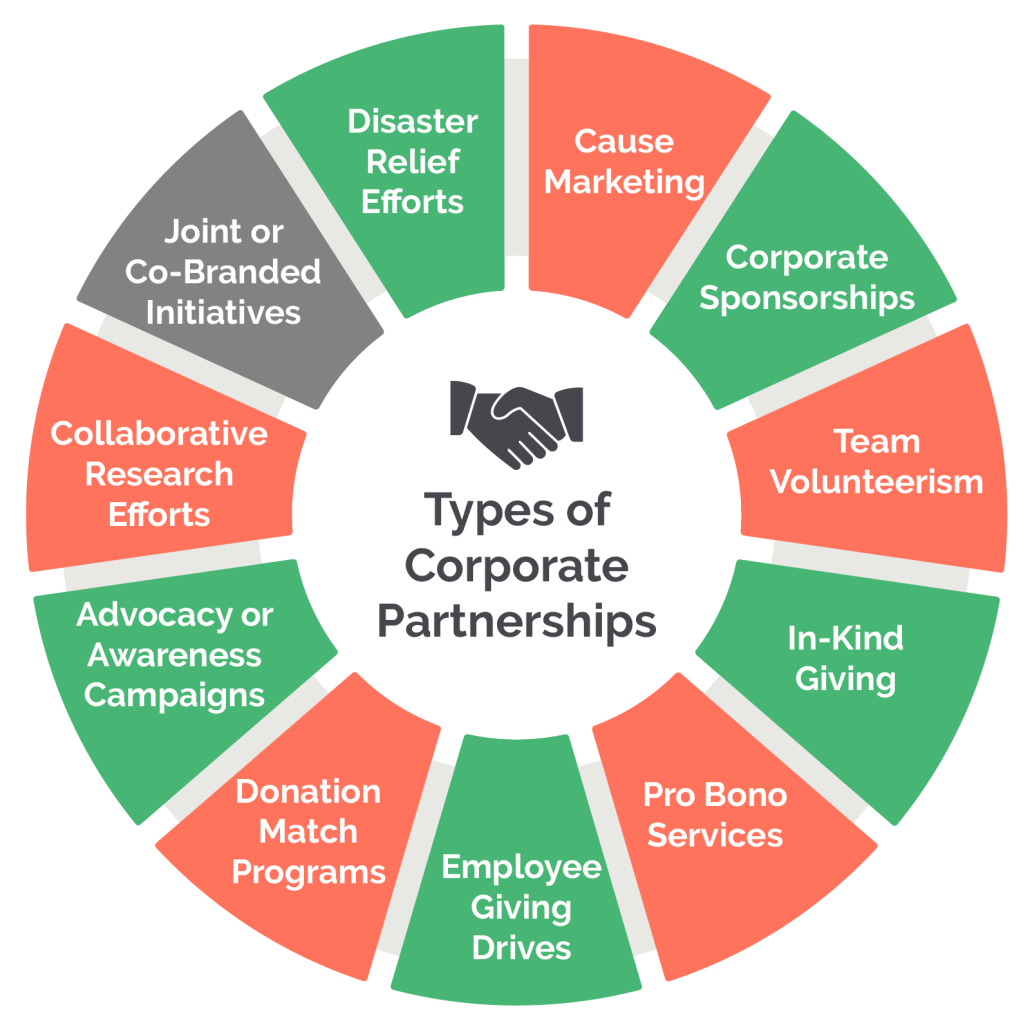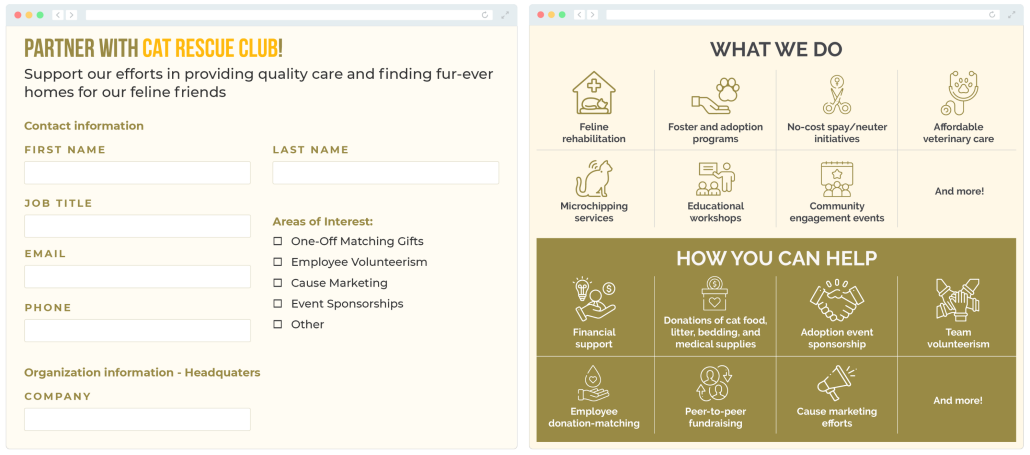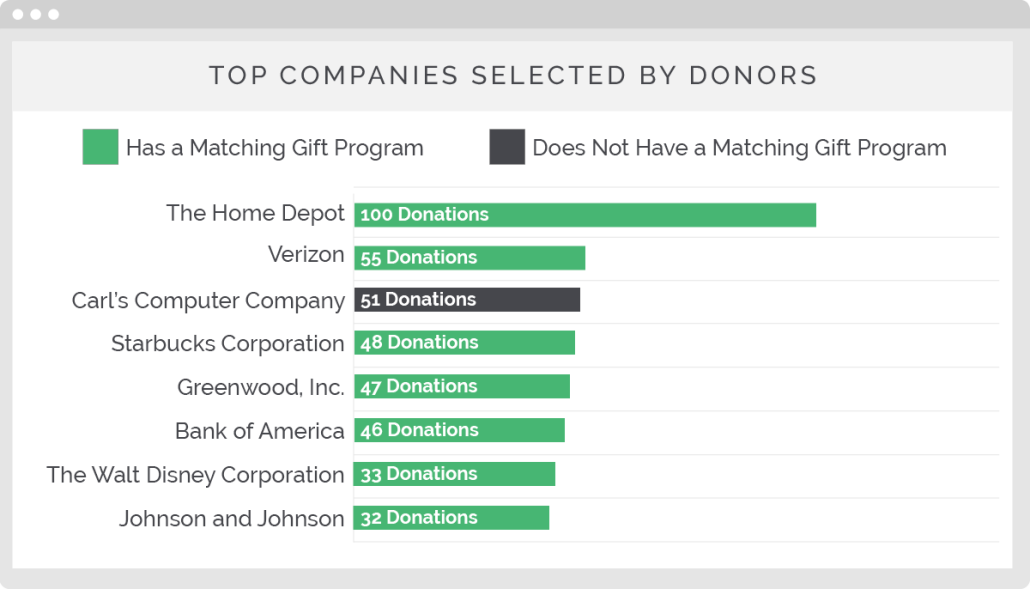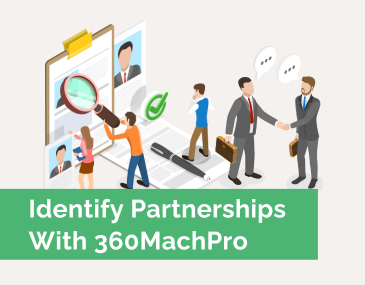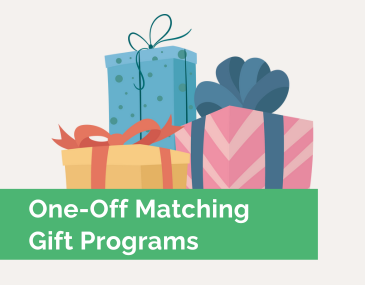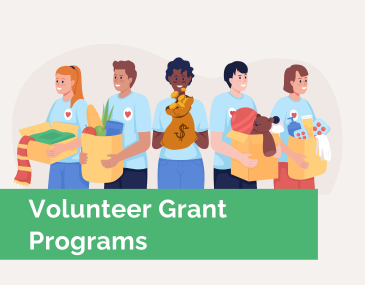The Fundraiser’s Guide to Powerful Corporate Partnerships
Corporate partnerships play a pivotal role in advancing nonprofits’ missions. Companies partaking in philanthropy supply charitable organizations with substantial amounts of funding—to the tune of $20 to $26 billion each year. And strategic partnerships are built to ensure that each party, the company and the organization, receives significant benefits from the relationship.
But many nonprofit fundraisers don’t know where to start.
Lucky for you, we aim to empower teams like yours as you learn to navigate corporate partnerships effectively. In this guide, we’ll walk through each of the following steps integral to establishing a constructive strategy.
These include…
- Understanding the Corporate Partnership Landscape
- Laying the Partnerships Groundwork
- Uncovering Prospective Corporate Partners
- Crafting a Persuasive Partnership Proposal
- Initiating Corporate Partnership Outreach
- Establishing a Strategy for Inbound Partnership Prospects
- Building and Maintaining Long-Term Corporate Relationships
- Bonus! Unlocking Partnerships With Corporate Giving Software
Ready to unlock new possibilities? Following this complete how-to can transform your approach to collaboration and elevate your fundraising game overall. In the end, you’ll unleash a powerful treasure trove of support for your cause.
Dive in to explore the intricacies of corporate partnerships, reveal tried-and-true strategies, and uncover innovative, tech-driven methods for success.
Understanding the Corporate Partnership Landscape
In order to best leverage the corporate partnership opportunity, it’s crucial that your team has a solid understanding of such collaborative efforts at large. Here are a few things you should know.
What Are Corporate Partnerships?
A corporate partnership is defined as a collaborative relationship between a nonprofit organization and a corporate entity.
These initiatives are generally characterized by shared objectives, mutual benefits, and strategic cooperation. In other words, a nonprofit and a company work together to achieve common goals and widely advantageous outcomes by leveraging their combined strengths, resources, and expertise.
These collaborations may go beyond traditional philanthropy, encompassing various forms of engagement that create positive social impact, promote community development, and enhance the brand image of both parties involved.
While the nature of these collaborations can vary widely, such partnerships typically result in long-term relationships rather than standalone giving initiatives.
Types of Corporate Partnerships to Consider
Corporate partnerships can come in all shapes and sizes, varying greatly based on the organization and the company involved. Despite their differences, each form of partnership holds unique benefits that significantly impact the success of the initiatives’ success.
These include:
With so many collaborative efforts to choose from, it’s likely your organization has already begun to benefit from partnering with charitable-minded businesses. Still, there’s always room to grow in your strategies and explore new types of partnerships. Open doors to fresh opportunities and expand the scope of your impact!
Laying the Partnerships Groundwork
To set the stage for successful partnerships, it’s important for organizations to lay a robust groundwork for collaboration. Think of this step as the prep work your team does before launching into your actual partnership-seeking strategy.
Your actions might include:
- Establishing and training a partnership team. Determine who, among your staff and volunteers, is best suited to be the face of your organization in partnership conversations. Then, ensure the team you’ve built is well-informed regarding your organization and can effectively communicate the value you bring to the table.
- Recognizing your organization’s core competencies. When preparing to pitch your nonprofit as a worthwhile partner, be sure to conduct an analysis that identifies your key strengths. For example, you might have a really strong donor base or an impressive international reach. Regardless, it will likely play into your value proposition.
- Analyzing your target audience. Overlapping audiences are a sign of a well-aligned partner relationship. Do your research beforehand to identify the demographics, interests, and preferences of your supporters. Then, use the information you gather to guide your next steps.
- Determining your goals and objectives. Make sure you’re seeking partnerships that meet your organization’s needs and goals. In order to do so, you’ll need to narrow your focus and ascertain the types of collaborations you seek. If you’re seeking corporate volunteer groups, for instance, you might want to prioritize companies with significant local workforces.
Successful partnerships begin with thoughtful planning, and these steps can go a long way in preparing your organization for the undertaking. Remember: the goal is ultimately to build lasting corporate relationships that not only meet your immediate needs but also align with your overarching mission and vision.
Uncovering Prospective Corporate Partners
Identifying opportune partners is the key to getting the most out of your organization’s efforts. You don’t want to pitch a partnership to any company you can think of. Rather, thorough research is paramount, empowering nonprofits to utilize their limited time and resources wisely. Plus, you can focus on prospects most likely to result in a positive return on your investment.
Consider employing a prospect rating system like this:
Careful analysis of potential corporate partners will allow your team to select the best partners. For optimal results, we recommend looking for:
- Aligning missions and values
- Existing philanthropy or CSR initiatives
- Previous nonprofit collaborations
- Financial health and giving capacity
- Media presence and brand image
- Overall reputation
- Trends and market analysis
Don’t forget about the power of your nonprofit’s support network, either!
Finding an existing connection to a business—whether that’s a donor, volunteer, board member, or other constituent—can open doors and significantly enhance the impact of your efforts.
How? Utilizing available contacts not only provides a warmer introduction but also adds a layer of trust and familiarity that positively influences the perception of your organization. Instead of a cold solicitation, you offer a personal and genuine interaction fueled by shared values and mutual associates.
To find out how your matching gift software can help at this stage, jump to that section now!
Crafting a Persuasive Partnership Proposal
The art of persuasion is fundamental to successful partnerships. You’re essentially selling your organization’s worth to prospective corporate parties.
Drafting a convincing proposal involves not just showcasing the initiative’s unique value proposition but also outlining the specific needs and opportunities of your cause.
Key Components of an Effective Partnership Pitch
- Executive Summary: Provide a concise overview of your nonprofit, its mission, and key highlights of the proposed partnership. Summarize the value proposition and the impact the partnership aims to achieve.
- Needs and Opportunities: Clearly articulate specific needs or opportunities the proposed partnership will address. Understand the challenges your organization faces that the corporate partner can help fill.
- Goals and Objectives: Define specific goals and objectives of the proposed partnership. Outline what both parties aim to achieve and how the collaboration aligns with broader strategic objectives on each side.
- Recognition and Visibility: Detail how the corporate partner will be recognized and the collaboration marketed. Include information on co-branded promotional opportunities, media exposure, and visibility within your organization’s own channels.
- Employee Engagement: Showcase opportunities for employee engagement, such as volunteer programs, team-building activities, or skills-based volunteerism. Highlight exactly how the partnership can enhance employee satisfaction and morale, and feel free to use statistics like these to help emphasize such benefits.
- Budget and Financials: Present a detailed budget that outlines how funds from the partnership will be utilized. Be transparent about the financial aspects, demonstrating accountability and responsible stewardship.
- Testimonials and Success Stories: Include testimonials or success stories from previous partnerships to help build your organization’s credibility. Highlight the positive experiences of other corporate partners, the impact they’ve made, and the tangible benefits they received by working with your cause.
- Timeline and Milestones: Propose an anticipated timeline that outlines the intended duration of your partnership endeavor. Clearly communicate the chronology for the execution of various initiatives and key activities.
- Call to Action: Plainly state the next steps and implement a specific call to action for the business to take. Include contact information for key individuals within your organization, and make it easy for the partner to initiate the partnership if they so choose.
Customizable Partnership Proposal Template
[Nonprofit] invites [company] to join forces to drive impact by supporting our endeavors in [specific project or program]. Please consider this proposal, which outlines a unique partnership opportunity to benefit both our organization and your company.
The [nonprofit] team seeks to [mission or vision], but we are facing [funding shortages, lack of resources, etc]. By collaborating, we can work together to address needs such as [mission-relevant need] and enhance the collective benefits offered by [nonprofit].
In taking on this effort, our primary goal is to [mission-relevant goal]. By fostering a partnership with [company], we believe we can provide value to your team in terms of [increased brand visibility, employee engagement, or other business goals].
Should you accept this proposal, [company] can expect to gain significant exposure through [branding opportunities, media exposure, communication channels, etc.]. [Company] would be prominently featured, driving widespread recognition and a positive reputation among consumers.
Not to mention, [company] employees can actively participate in [volunteer programs, workplace giving initiatives, or other partnership activities], thus contributing to team-wide engagement, boosting morale, and increasing staff retention rates.
Our detailed budget ensures transparency and illustrates the concrete impact of your investment in [nonprofit]. With a contribution of $[funding request] from [company] and expected expenses of $[estimated expenditures], we anticipate a significant return on investment for the program.
Past partners, including [other company], have experienced [specific positive experiences], and we believe that [company] would benefit in many of the same ways.
We propose a partnership that would span [timeline], with key milestones occurring at [specific milestone and timetable] to establish a framework for impending success.
Please contact [name] at [email address] or [phone number] to discuss the potential of a partnership with [nonprofit]. Thank you for your consideration, and we look forward to exploring the next steps together.
Establishing a Strategy for Inbound Partnership Prospects
While nonprofits traditionally source most of their own corporate relationships, being prepared for inbound interest from potential partners is equally crucial. One of the best ways you can do so is by creating a page on your organization’s website dedicated to getting involved in corporate partnerships.
Such a page should include…
- A high-level overview of your mission or cause and how partnership funds will be used
- Numerous ways a company can get involved through partnerships, such as workplace giving, sponsorship events, or cause marketing
- Corporate partnership benefits for companies, including brand visibility, tax deductions, employee engagement, and more
- An embedded interest form that allows potential partners to supply contact information and other useful details
- Information encouraging interested companies to work with a CSR platform—specifically one equipped with auto-submission functionality—to help streamline the organization and management of corporate partnerships
You’ll also want to plan how your organization will respond to the inbound interest you receive. Once a company expresses interest in working together (e.g., by filling out the contact form on your site), your team will need to follow up, thank them for their interest, and engage in a conversation about the possible partnership.
Initiating Corporate Partnership Outreach
Proactive outreach is a core component of successful corporate partnerships.
Once you feel prepared to begin your outreach, you’ll want to determine the key decision-makers within the corporation. This might include those in the corporate social responsibility, marketing, community engagement, or executive leadership departments. The goal is to get your pitch in front of the company’s decision-makers!
It’s worth noting that leveraging any personal connections or common contacts within the corporate organization can significantly facilitate the initial introduction. Such connections not only enhance credibility but also increase the likelihood that your proposal will receive consideration.
When making your initial outreach, it’s a good idea to propose a low-commitment interaction. For example, a brief introductory call, virtual meeting, or coffee chat allows for a casual and exploratory conversation. You’ll have the space to discuss potential collaboration without placing immediate pressure on the prospective partner.
Prior to engaging in discussion, make an effort to anticipate potential concerns or objections from your prospective partner. Then, prepare a thoughtful response beforehand. Approach discussions with respect, empathy, and a focus on mutual success, and be open to innovative approaches that meet the interests of both parties.
Following the initial contact, follow up promptly with a personalized thank-you message, showing your gratitude for the company’s consideration. Remember to reiterate your interest in the potential partnership, supply any additional information or materials, and express openness to further discussions.
Building and Maintaining Long-Term Corporate Relationships
It’s easier (and more cost-effective) to retain long-term corporate relationships than it is to be constantly on the lookout for new, one-off partnership opportunities. That’s why, from the beginning, it’s important to approach potential partners as an opportunity for genuine, mutually beneficial relationships—rather than focusing solely on the transactional value.
Aim to foster a lasting connection by making a commitment to collaboration and maintaining regular and transparent communication. Implementing these best practices in your partnership strategy can help you do so:
- Provide impact updates on the companies’ support, share success stories, and keep partners informed about upcoming initiatives and ways to stay involved.
- Acknowledge and celebrate corporate partners above and beyond what’s outlined in your agreement, when possible—on your website, social media pages, promotional materials, and more.
- Establish a process for gathering feedback regarding the partnership experience. Then, use the input provided to refine and improve your corporate engagement efforts.
- Engage employees of your partner company by offering opportunities to partake in volunteer activities, event participation, peer-to-peer fundraising, and more.
All in all, you’ll want to identify opportunities to deepen the existing relationship with corporate connections. As your partnership progresses, make it a priority to work collaboratively and develop a roadmap for future collaboration and growth.
Bonus! Unlocking Partnerships With Corporate Giving Software
Does your organization invest in the industry’s leading matching gift solution, Double the Donation? If so, it can be one of your greatest assets as your team begins sourcing corporate partnerships.
While corporate partnerships can encompass a lot more than employee matching gifts alone, there’s a close relationship between the two concepts. As such, you can use data collected from one initiative (matching gifts) to inform your strategy for the other (broader corporate partnerships). And Double the Donation built its platform to help.
Plus, leveraging a solution equipped with auto-submission not only streamlines the process for your own team but also enhances the partnership experience on the company’s end by demonstrating proactive engagement and efficiency.
Using Double the Donation’s Sponsorship Search Functionality
Historically providing information about matching gifts and other employee-led giving initiatives, Double the Donation has recently expanded into the broader corporate partnerships space. With their updated database, you can now access information that goes beyond matching gifts to include corporate giving programs like sponsorships, in-kind giving opportunities, and more.
When using the search tool, simply enter a company’s name. The system will display detailed information about that company’s corporate philanthropy efforts, including types of nonprofits they support, giving guidelines, and whether they have sponsorship or partnership programs in place. Many listings also include direct links to applications and contact details for key decision-makers in corporate social responsibility (CSR) departments, which can be incredibly helpful for outreach.
Using Double the Donation’s ‘Leading Companies’ Tool
You know that companies with which you share personal connections can be your organization’s most valuable prospects. Such connections showcase overlapping audiences and demonstrate the potential benefits a partnership can bring. Your donors’ employers are some of the best examples of this—and that data is already stored within Double the Donation.
That said, take a look at the companies featured in your organization’s “Leading Companies” tool (under the reporting tab) within the platform. This feature displays the companies most often selected by your donors as they interact with your employer search tool on your donation form or email follow-ups. And it means they’re companies well-represented within your donor base.
Once equipped with your list of top employers, you can divide prospects into two categories (which are already conveniently color-coded in Double the Donation). These include:
Companies with existing matching gift programs
These are companies that employ a significant number of your donors and have already proven to be philanthropic in nature. Reach out and see if they’d consider a supplemental partnership—such as a sponsorship, volunteer event, or donation drive. If it actively engages the company’s employees (and your supporters!), even better.
Consider this helpful template to get you started:
Subject: Grow your philanthropy by partnering with [nonprofit] today!
Dear [corporate contact],
Over the years, [nonprofit] has been incredibly grateful for the support from [company] and its particularly philanthropic employee base. Your ongoing support through such a generous matching gift program allows us to better our communities by [specific project or program] and [specific project or program].
In the last twelve months, our organization has received [number] donations and identified over $[total matching gift revenue] worth of matching gifts from your company. We know that you are already dedicated to charitable giving, and it seems like we have a lot in common already.
Today, we’re reaching out to discuss your potential interest in partnering with our team as a corporate sponsor for [upcoming event, project, or program]. This would allow you to grow your support beyond matching gifts and get your workforce involved in new and exciting ways.
Thank you for considering this opportunity, and we look forward to the chance to create a more profound impact together.
Best regards,
[Name]
[Contact information]
[Nonprofit]
Companies without existing matching gift programs
Companies lacking matching gift programs but prevalent within your donor base may be interested in easy ways to step into the corporate philanthropy realm. Utilize your shared audiences to demonstrate value and propose a partnership opportunity with mutual benefits.
One-off matching gift initiatives are an excellent option in this case as it allows an employer to explore donation-matching in a limited-scope environment. And Double the Donation makes it easy to manage such initiatives within an organization’s matching gift portal using the one-off program management feature!
Consider this helpful template to get you started:
Subject: Exploring partnership opportunities alongside [nonprofit]
Hi, [company] team!
I trust this email finds you well. I wanted to reach out on behalf of [nonprofit], an organization dedicated to [mission or vision] in the [geographic region] area.
We see that over [number] of our generous donors are employed by your company. However, it appears that you do not currently offer a matching gift program.
Because our teams have so much in common already, we thought you might be interested in exploring the possibility of a mutually beneficial collaboration. We believe that by establishing a partnership, we could create a more significant and lasting impact on the causes that matter most to all of us. Could we schedule a brief call to discuss possibilities?
Thank you for your consideration,
[Name]
[Title]
[Nonprofit]
You always want to make the most of the tools in your nonprofit’s toolkit. This often-overlooked feature in Double the Donation can provide invaluable insights for your partnership strategy—so long as you know what to do with the information at your fingertips.
Not yet a Double the Donation client? Get a demo of the platform to see how it will elevate your matching gift and corporate partnership efforts.
Final Thoughts & Additional Resources
With this helpful roadmap in hand, we hope your team can pursue and cultivate powerful corporate relationships. As you embark on the journey, feel encouraged to approach each potential partnership with intention, creativity, and a deep commitment to mutually beneficial outcomes, creating lasting positive change. Plus, make the most of the resources at your disposal (such as your matching gift software) to produce the greatest impact possible for your cause.
The result? Increased revenue through additional philanthropy opportunities and stronger partnerships that bring each team to new heights.
Interested in learning more about effective corporate partnership strategies? Check out these recommended resources for further reading:
Double the Donation can help your team locate its greatest potential partners. Find out how you can do so in this guide to corporate partnership identification.
One-off (or custom) matching gift programs are easy and powerful corporate partnerships. See how your nonprofit can build personal employee giving initiatives!
Don’t overlook the power of corporate volunteerism! Many companies even provide “dollars for doers” grants to the organizations with which their employees volunteer.


